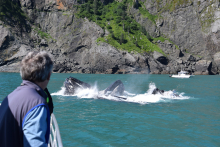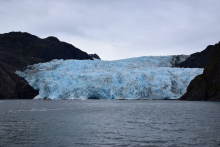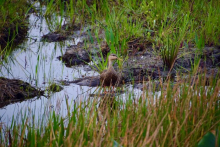What Are They Doing?
 A giant sea spider towers over a field of polyps at Turtle Rock, Antarctica. Photo by Timothy R. Dwyer.
A giant sea spider towers over a field of polyps at Turtle Rock, Antarctica. Photo by Timothy R. Dwyer.
Cold-blooded animals in the Antarctic ocean have survived in near-constant, extreme cold conditions for millions of years and are very sensitive to even small changes in water temperature. However, the consequences of this extreme thermal sensitivity for the energetics, development, and survival of developing embryos is not well understood.
This project will investigate the effect of temperature on the metabolism, growth rate, developmental rate, and developmental energetics of embryos and larvae of Antarctic marine ectotherms. The project will also measure annual variation in temperature and oxygen at different sites in McMurdo Sound, and compare embryonic and larval metabolism in winter and summer to determine the extent to which these life stages can acclimate to seasonal shifts. This research will provide insight into the ability of polar marine animals and ecosystems to withstand warming polar ocean conditions.
Where Are They?
 A dive hole inside the dive hut just off of the shores of McMurdo Station, Antarctica. Photo by Jennifer Bault.
A dive hole inside the dive hut just off of the shores of McMurdo Station, Antarctica. Photo by Jennifer Bault.
The team will be based out of McMurdo Field Station, Antarctica and will be taking day trips to a variety of dive sites. They will drive to most of their sites via PistenBully, though a few will be accessed by helicopter.
Latest Journals

Dr. Moran studies the physiological ecology and evolutionary ecology of marine invertebrates, with a particular focus on early life history stages – embryos and larvae. One major area of emphasis is the effects of temperature on the energy dynamics of growth and development, and in recent years she has studied polar gigantism in both sea slugs and sea spiders. A second area of emphasis is the effects of temperature on growth, development, and success in many invertebrates including barnacles, sea urchins, worms, and snails; current work in Hawaii also looks at the effects of warm-water events and bleaching on the reproductive success of corals. She is an associate professor at the University of Hawaiʽi at Mānoa. (http://www.moranlab.org)





